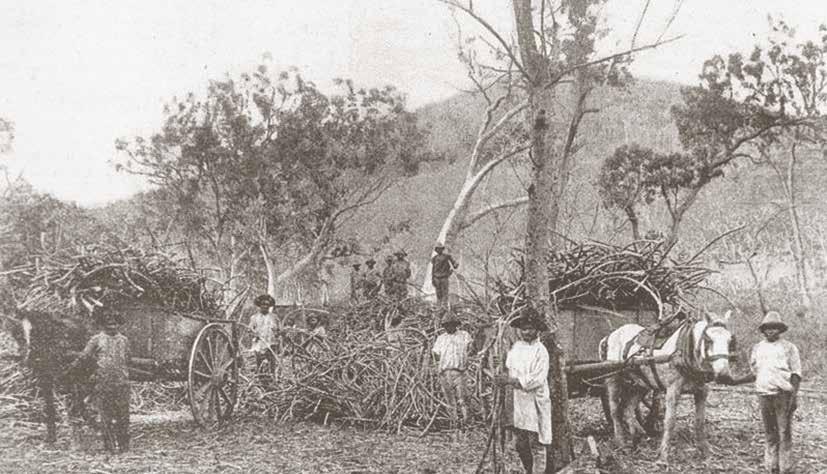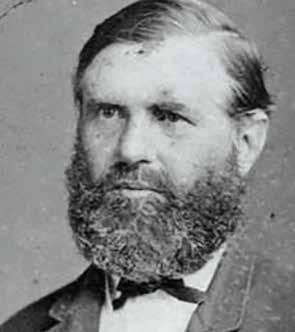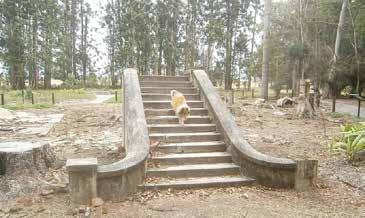
4 minute read
History
Pioneers grow COTTON & SUGAR
By Barry Clark Bribie Island Historical Society
Advertisement
Long before anyone or anything was happening on Bribie Island, in the 1860s pioneer settlers tried first to grow cotton, and then sugar, on the Caboolture River. They had much to learn in that early “multicultural” environment. George Raff was a businessman and politician who had emigrated from Scotland to Sydney in 1839. He married the daughter of a retired missionary and moved to Brisbane in 1851 for new trade and investment opportunities. His house in New Farm he named Moraybank, a reference to his native Morayshire in Scotland.

Raff helped to establish direct wool trade between Brisbane and London. As a politician, he campaigned for the separation from NSW and served as a member of Queensland’s first Parliament. With others, in 1861 he set up the Caboolture Cotton Co., one of 10 cotton companies established in Queensland, using expensive imported equipment
George Raff
MORAYFIELD
Raff built the large plantation homestead beside the Caboolture River, on a slight rise to protect from flooding, with outhouses, separate kitchen, carriage house and stables. The large property, he named Morayfield, was on rich alluvial soil, surrounded on three sides by the Caboolture River. With 120 acres of cotton crops, it suffered severely in disastrous floods of March 1863, after which they soon switched from growing Cotton to Sugar.
In the same year, Captain Claudius Whish, ex Indian Army, also established an adjacent property, which he named Oatlands, further up the Caboolture River.
The bridge over the Caboolture River, on the Bruce highway, is called Cpt. Whish Bridge, passing through the original Oatlands property.
Morayfield 1873

KANAKA LABOUR
These plantations were substantial undertaking, in what was then a very remote area of European settlement. Access by land was difficult and everything came by steamships up the winding Caboolture River. Sugar cultivation, processing and distilling became well established. Several kilometres of cane transport Tramways were constructed, and by 1868, sugar exported by river steamer, and 18,000 gallons of rum was produced. Between 1863 and 1904, more than 62,000 Kanakas were brought to Queensland from New Caledonia and Vanuatu as cheap labour. Plantations were isolated communities, police were often days away, and treatment was harsh. The Reverend John Dunmore Lang visited the Morayfield plantation in 1868, to report on the treatment of Kanakas, at what was then one of the largest sugar plantations in Queensland. SUGAR GROWING STOPS

After years of regular flooding of the Caboolture River, sugar-growing stopped in 1884. George Raff died in 1889, equipment was removed, land
subdivided, and by 1909 new owner James Buchanan ran the largest milking dairy herd in Caboolture district with 250 head. He sent cream to the Caboolture butter factory and leftover milk went to fatten pigs The river flats were extensively flooded again in 1953. Raff’s old plantation house abandoned, and a new house built on higher ground. In 1960, APM Forests Pty. Ltd. purchased the land, and for the next 40 years, it was a Pine Plantation. In early 2000s work began on the extensive North Harbour Residential Development and Business Park.
Morayfield old stone steps
HERITAGE PARK
culturally significant, added to the Queensland Heritage Register, and a Heritage Park established. Informative signage has been erected, Information centre built, guide brochure printed, and the facility is open daily to the public. The stone steps of the original Plantation house
The blacks assembled in large numbers at the company’s plantation on the Caboolture River have exhibited a hostile demeanour towards company servants, and have actually by force opposed the return of a cutter sent down with labourers and stores. I am directed to request that the whites on the plantation, who are apprehensive of an attack, may be afforded police protection with as little delay as possible, and that steps may be taken to disperse the blacks at present assembled.
can still be seen, and a gravestone stands as a silent sentinel on the riverbank to Levi Walker who was just 27 when he emigrated from Scotland to Australia in 1869. He found work labouring at Morayfield plantation but sadly drowned just six weeks later in the unpredictable Caboolture River. NORTH HARBOUR HERITAGE PARK.
This is a little known new local attraction, created in partnership with the Abbey Museum of Art & Archaeology. I have recently taken members of the Historical Society and U3A for informative walks, with our guide Cheryl Thornley, a teacher’s aide at Bribie Island State School, who lived in the old Morayfield plantation house as a child in the 1950’s.
DISPERSED
The term “Dispersed” was often used in official documents of early European settlement in Moreton Bay, in relation to Aboriginal people. They were fast losing control of their tribal land, and can only imagine the issues resulting from the arrival of Kanakas. Let me finish with an extract from a letter, dated 10 Oct 1861, from the Caboolture Cotton Co. to the Colonial Secretary.
MORE BRIBIE HISTORY
The Historical Society meets on the second Wednesday of the month at 6; 30pm at the RSL Club. Visitors and new members welcome, with notification. You can see many more articles on our Blog Site http://bribieislandhistory. blogspot.com or contact us on bribiehistoricalsociety@ gmail.com








